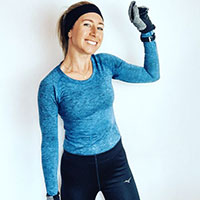
Some people run marathons for charity, some want to check the accomplishment off their bucket list, some run to lose weight and some even do it to prove a friend wrong. There's no wrong or right reason to run 26.2, but your goal for taking on the distance will determine how you go about it. Racing for a PR requires serious training and mental determination.
Here are three key workouts for shaving seconds or even minutes off your marathon time.
Hill Repeats
Doing repeats up a hill builds strength and conditions the body to expect and handle some punishment. They also help your muscles use oxygen more efficiently. Uphill is the go-to, but don't neglect doing downhill as well. Running downhill promotes good form and preps the body for handling harsh impact.
However, while both are important, don't do them together! These runs should be done separately and spaced out for enough recovery. For uphill workouts, find a short, steep climb to do sets of 60-second repeats. Start with a few and work your way up to 20. The effort should be roughly 80 percent while your rest occurs as you walk downhill. For downhill repeats, work your way up to 10 on a slightly longer and less steep grade. Focus on good form over speed.
6 Sets of 5-Minute Repeats
This workout is a variation of a tempo run. Instead of a steady 90-minute run, breaking it into a warm up, intervals and a cool down. It will be more challenging and stimulating for your body and mind. Aim for 15 minutes of easy running to get your body moving before beginning the intervals. Each 5-minute effort should be at half marathon pace. Start at three intervals and build your way to six with 2 to 3 minutes of easy jogging between each. When your intervals are done, make sure to get in at least 10 minutes of easy jogging to cool down.
Progressive Long Run
Building endurance is key to thriving in a marathon. To go 26.2 without dying at the end, you'll need to increase your long run distance throughout training. Most runners know a long run is important, but simply increasing distance isn't enough to get a PR.
To improve running endurance without losing steam, start slow and pick up the pace each mile. Begin the run at your easy pace, speeding up roughly 10 seconds every mile or two to end the run at half marathon pace. This will challenge your pacing skills, help promote a negative split race and get your body ready to maintain pace when fatigue sets in.
There are many workouts that can be used to improve fitness, gain speed and build strength, so don't feel limited to just these three. However, these workouts are often neglected and could be just what you need to put a little speed in your step. Another run that shouldn't be ignored is the easy run. It might not be thought of as a workout, but taking that easy run VERY easy is an often-ignored part of giving your body the recovery it needs to push hard when you need to.
READ THIS NEXT: 3 Workouts to Make You Run Faster
About the Author

Get ACTIVE on the Go


Couch to 5K®
The best way to get new runners off the couch and across the finish line of their first 5K.
Available for iOS | Android






Discuss This Article